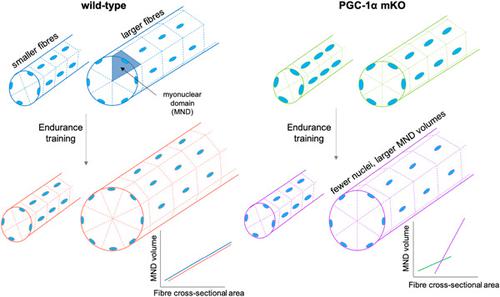当前位置:
X-MOL 学术
›
J. Cell. Physiol.
›
论文详情
Our official English website, www.x-mol.net, welcomes your
feedback! (Note: you will need to create a separate account there.)
PGC-1α regulates myonuclear accretion after moderate endurance training
Journal of Cellular Physiology ( IF 4.5 ) Pub Date : 2021-07-28 , DOI: 10.1002/jcp.30539 Edmund Battey 1, 2 , Regula Furrer 3 , Jacob Ross 2 , Christoph Handschin 3 , Julien Ochala 1, 4, 5 , Matthew J Stroud 2
Journal of Cellular Physiology ( IF 4.5 ) Pub Date : 2021-07-28 , DOI: 10.1002/jcp.30539 Edmund Battey 1, 2 , Regula Furrer 3 , Jacob Ross 2 , Christoph Handschin 3 , Julien Ochala 1, 4, 5 , Matthew J Stroud 2
Affiliation

|
The transcriptional demands of skeletal muscle fibres are high and require hundreds of nuclei (myonuclei) to produce specialised contractile machinery and multiple mitochondria along their length. Each myonucleus spatially regulates gene expression in a finite volume of cytoplasm, termed the myonuclear domain (MND), which positively correlates with fibre cross-sectional area (CSA). Endurance training triggers adaptive responses in skeletal muscle, including myonuclear accretion, decreased MND sizes and increased expression of the transcription co-activator peroxisome proliferator-activated receptor-γ coactivator-1α (PGC-1α). Previous work has shown that overexpression of PGC-1α in skeletal muscle regulates mitochondrial biogenesis, myonuclear accretion and MND volume. However, whether PGC-1α is critical for these processes in adaptation to endurance training remained unclear. To test this, we evaluated myonuclear distribution and organisation in endurance-trained wild-type mice and mice lacking PGC-1α in skeletal muscle (PGC-1α mKO). Here, we show a differential myonuclear accretion response to endurance training that is governed by PGC-1α and is dependent on muscle fibre size. The positive relationship of MND size and muscle fibre CSA trended towards a stronger correlation in PGC-1a mKO versus control after endurance training, suggesting that myonuclear accretion was slightly affected with increasing fibre CSA in PGC-1α mKO. However, in larger fibres, the relationship between MND and CSA was significantly altered in trained versus sedentary PGC-1α mKO, suggesting that PGC-1α is critical for myonuclear accretion in these fibres. Accordingly, there was a negative correlation between the nuclear number and CSA, suggesting that in larger fibres myonuclear numbers fail to scale with CSA. Our findings suggest that PGC-1α is an important contributor to myonuclear accretion following moderate-intensity endurance training. This may contribute to the adaptive response to endurance training by enabling a sufficient rate of transcription of genes required for mitochondrial biogenesis.
中文翻译:

PGC-1α在中等耐力训练后调节肌核增生
骨骼肌纤维的转录需求很高,需要数百个细胞核(肌核)来产生专门的收缩机制和沿其长度的多个线粒体。每个肌核在空间上调节有限体积的细胞质中的基因表达,称为肌核结构域 (MND),它与纤维横截面积 (CSA) 呈正相关。耐力训练触发骨骼肌的适应性反应,包括肌核增生、减少 MND 大小和增加转录共激活因子过氧化物酶体增殖物激活受体-γ coactivator-1α (PGC-1α) 的表达。先前的研究表明,骨骼肌中 PGC-1α 的过表达可调节线粒体生物发生、肌核增生和 MND 体积。然而,PGC-1α是否对这些适应耐力训练的过程至关重要尚不清楚。为了测试这一点,我们评估了经过耐力训练的野生型小鼠和骨骼肌中缺乏 PGC-1α (PGC-1α mKO) 的小鼠的肌核分布和组织。在这里,我们展示了由 PGC-1α 控制并取决于肌纤维大小的耐力训练的不同肌核增生反应。在耐力训练后,MND 大小和肌纤维 CSA 的正相关关系趋向于 PGC-1a mKO 与对照组相比更强的相关性,这表明肌核增生随着 PGC-1α mKO 中纤维 CSA 的增加而受到轻微影响。然而,在较大的纤维中,MND 和 CSA 之间的关系在训练与久坐的 PGC-1α mKO 中显着改变,表明PGC-1α对这些纤维中的肌核增生至关重要。因此,核数与 CSA 之间存在负相关,这表明在较大的纤维中,肌核数无法与 CSA 成比例。我们的研究结果表明,PGC-1α 是中等强度耐力训练后肌核增生的重要贡献者。这可能有助于通过使线粒体生物发生所需的基因有足够的转录率来促进对耐力训练的适应性反应。
更新日期:2021-07-28
中文翻译:

PGC-1α在中等耐力训练后调节肌核增生
骨骼肌纤维的转录需求很高,需要数百个细胞核(肌核)来产生专门的收缩机制和沿其长度的多个线粒体。每个肌核在空间上调节有限体积的细胞质中的基因表达,称为肌核结构域 (MND),它与纤维横截面积 (CSA) 呈正相关。耐力训练触发骨骼肌的适应性反应,包括肌核增生、减少 MND 大小和增加转录共激活因子过氧化物酶体增殖物激活受体-γ coactivator-1α (PGC-1α) 的表达。先前的研究表明,骨骼肌中 PGC-1α 的过表达可调节线粒体生物发生、肌核增生和 MND 体积。然而,PGC-1α是否对这些适应耐力训练的过程至关重要尚不清楚。为了测试这一点,我们评估了经过耐力训练的野生型小鼠和骨骼肌中缺乏 PGC-1α (PGC-1α mKO) 的小鼠的肌核分布和组织。在这里,我们展示了由 PGC-1α 控制并取决于肌纤维大小的耐力训练的不同肌核增生反应。在耐力训练后,MND 大小和肌纤维 CSA 的正相关关系趋向于 PGC-1a mKO 与对照组相比更强的相关性,这表明肌核增生随着 PGC-1α mKO 中纤维 CSA 的增加而受到轻微影响。然而,在较大的纤维中,MND 和 CSA 之间的关系在训练与久坐的 PGC-1α mKO 中显着改变,表明PGC-1α对这些纤维中的肌核增生至关重要。因此,核数与 CSA 之间存在负相关,这表明在较大的纤维中,肌核数无法与 CSA 成比例。我们的研究结果表明,PGC-1α 是中等强度耐力训练后肌核增生的重要贡献者。这可能有助于通过使线粒体生物发生所需的基因有足够的转录率来促进对耐力训练的适应性反应。











































 京公网安备 11010802027423号
京公网安备 11010802027423号